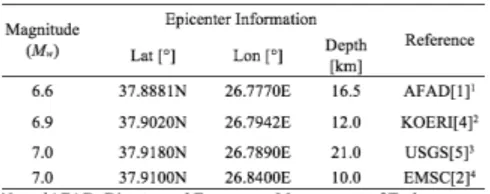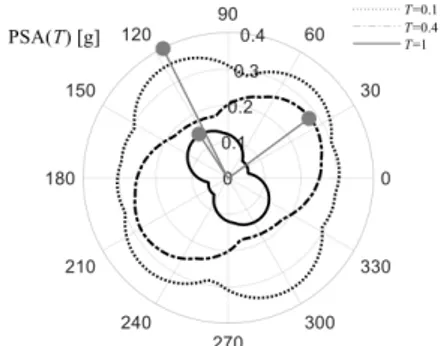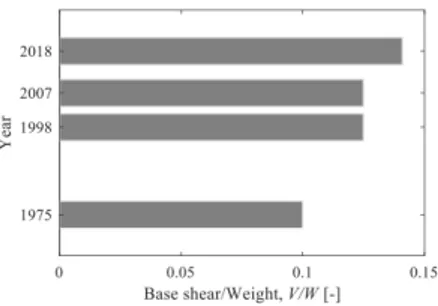Anahtar Kelimeler: 2020 Aegean Sea Earthquake, Local site properties, Structural damage, Strong
ground motion records
PRELIMINARY OBSERVATIONS AFTER THE
2020 AEGEAN SEA EARTHQUAKE
Ziya MÜDERRİSOĞLU*, Hasan ÖZKAYNAK**
ABSTRACT
The October 30, 2020 Aegean Sea Earthquake occurred with a magnitude of M6.6 and caused significant damages across the city of Izmir, Turkey. Specifically, this paper presents the preliminary observation results based on; ground motion properties, local site conditions, code-based design procedures, and the structural damage mechanisms. In order to achieve this purpose, critical spectral characteristic of strong ground motion records were evaluated in advance. Then, the variables given in code-based design results were investigated based on base shear to structural weight ratio. Local site effects were considered by comparing the spectral amplitudes obtained for different strong ground motions recorded from stations with different soil characteristics (i.e. the shear wave velocity (VS30) averaged over top 30m of the soil profile). Primary temporal distributions of recorded earthquake sequences followed by the mainshock were detailed and the directionality characteristics of the strong ground motion recorded after the mainshock were summarized. Moreover, observed damage patterns in buildings are discussed and possible reasons were identified in terms of critical structural properties. Preliminary results generally represent the effect of local soil characteristics on the amplification of spectral properties.
*Received: 23.11.2020 ; Accepted : 10/03/2021 Type: Research DOI: 10.20854/bujse.829973
*Corresponding author: Department of Civil Engineering, Beykent University, 34398, Istanbul, Turkey ** Department of Civil Engineering, Beykent University, 34398, Istanbul, Turkey
BEYKENT ÜNİVERSİTESİ FEN VE MÜHENDİSLİK BİLİMLERİ DERGİSİ CİLT SAYI:13/2
Anahtar Kelimeler: 2020 Ege Denizi Depremi, Yerel zemin koşulları, Kuvvetli yer hareketi kayıtları
2020 EGE DENİZİ DEPREMİ SONRASINDAKİ İLK
GÖZLEMLER
Ziya MÜDERRİSOĞLU*, Hasan ÖZKAYNAK**
ÖZET
30 Ekim 2020 tarihinde Ege Denizi’nde meydana gelen M6.6 büyüklüğündeki deprem özellikle İzmir ve çevresinde önemli hasar ve yıkımlara neden olmuştur. Çalışma kapsamında, yer hareketi özellikleri, yerel zemin koşullarının bina hasarları üzerindeki etkisi, mevcut binalarda kullanılan tasarım yaklaşımları ve yapısal hasar mekanizmaları gibi temel konulara bağlı olarak, deprem sonrasında gerçekleştirilen ilk gözlem sonuçlarına yer verilmiştir. Bu amaçla, öncelikle kuvvetli yer hareketi kayıtlarına ait kritik spektral parametreler belirlenmiştir. Farklı yıllarda yürürlükte olan tasarım yönetmeliklerindeki esaslar dikkate alınarak, tasarım değişkenlikleri taban kesme kuvveti ile bina ağırlığı arasındaki oran dikkate alınarak incelenmiştir. Yerel saha koşullarının etkisi, farklı zemin koşullarına sahip (örn, zemin profilinin ortalama 30m seviyesindeki kayma dalgası hızı, VS30) istasyonlardan elde edilen kuvvetli yer hareketi kayıtlarına ait spektral büyüklüklerin karşılaştırılmasıyla dikkate alınmıştır. Ana deprem sonrasında belirli bir süre içerisinde bölgede gözlemlenen deprem serileri incelenmiş ve ana deprem kaydına ait yönlülük karakteristiği farklı periyotlar için incelenmiştir. Binalarda meydana gelen hasar dağılımları üzerine tespitlerde bulunulmuştur. Elde edilen ilk gözlem sonuçları genel olarak, bölgedeki farklı zemin özelliklerinin kuvvetli yer hareketi kayıtlarına ait spektral değerlerinde yükseltgenmelere yol açabildiği belirlenmiş ve binalarda oluşan yapısal hasarların olası nedenleri üzerine tartışmalara yer verilmiştir.
*Makale Gönderim Tarihi:23.11.2020 ; Makale Kabul Tarihi :10/03/2021 Makale Türü: Araştırma DOI: 10.20854/bujse.829973. *Sorumlu yazar: İnşaat Mühendisliği Bölümü, Beykent Üniversitesi, 34398, İstanbul, Türkiye
1. Introduction
The 2020 Aegean Sea Earthquake caused significant damages and casualties across the city of Izmir, Turkey (October 30, 2020 11:51:24(UTC)&14:51:24(Local)). The epicenter of event was announced as the Aegean Sea, off the coast of Seferihisar (Izmir) [1]. Seismic details recorded by major networks are provided in Table 1. Moreover, structural damages and casualties were recorded in Samos Island [2] and floods were reported after the earthquake [3]. As the affected area is located in a high seismicity region, damaging earthquakes were also recorded in past years. Major events occurred in last 50 years include the March 28, 1970 M7.0 Kızık-Cavdarhisar Earthquake, the March 27, 1975 M6.7 Gulf of Saros Earthquake, the December 19, 1981 M7.2 Aegean Sea Earthquake, and the July 21, 2017 M6.6 Gulf of Gokova Earthquake.
2. Strong Ground Motion Characteristics
Following the October 30, 2020 Aegean Sea Earthquake, strong ground motion data were recorded in stations located around the affected region (Figure 1).
Specifically, the peak ground acceleration, PGA values were evaluated by using the strong ground motion components of closest stations to epicenter reported by Disaster and Emergency Management of Turkey [6] are summarized in Table 2.
The pseudo spectral accelerations (PSAs) recorded during the October 30, 2020 Aegean Sea Earthquake evaluated via using the data obtained from database [6] (Figure 2). The amplifications effects could apparently be seen especially from 0905 station.
BUJSE 13/2 (2020), 43-50 DOI: 10.20854/bujse.829973
Table 1: General information about the event
Figure 1: Time histories of strong ground motion records: North-South component of: a) Acceleration, b) velocity, and c) displacement
Figure 2: Pseudo spectral acceleration
In order to compare the design spectra (i.e. Specification for Buildings to be Built in Seismic Zones [7], and Turkish Seismic Design Code [8]) and the strong ground motion characteristics, Figure 3 is provided as below. Accordingly, the geometric mean of two perpendicular components of strong motion record having the highest PGA value (i.e. 0.183g-NS-0905, [6]) is taken into account. As the shear wave velocity, VS30 averaged over top 30m of the soil profile is provided as 369m/s, design spectra are created for related site properties. It should be noted that the spectral values of earthquake recorded from 0905 station is much more lower than
Figure 3: Comparison between the Turkish Design Spectra of [7], [8], and the pseudo spectral acceleration To assess the effects of local site conditions on the affected regions across the city of Izmir, spectral acceleration characteristics recorded at different stations located near the related regions are estimated (Figure 4). Specifically, pseudo spectral accelerations obtained from the database of nearest stations [6] to the highly affected regions are considered (i.e. Station 3513 for Bayraklı, and Station 3522 for Bornova). Local site characteristics of related stations are identified in terms of VS30 values that are reported as 196m/s and 249m/s for stations 3513 and 3522, respectively [4]. Here, the largest pseudo spectral acceleration values are approximately recorded between 0.25~1.2s. As this range corresponds to the fundamental vibration periods of buildings having 3 to 12 stories, significant damages in the related region were observed for such buildings. Moreover, amplification for spectral values recorded in related regions are observed for lower values of shear wave velocity, VS30 averaged over top 30m of the soil
BUJSE 13/2 (2020), 43-50 DOI: 10.20854/bujse.829973
3. Seismic Activity after the Mainshock
Following the October 30, 2020 Earthquake, several earthquakes occurred in the affected region. Seismic activity recorded within a time interval of eight days started from the mainshock event is considered (Figure 5a). Earthquakes recorded within 100km from the epicenter are taken into account based on a method proposed by [9]. Earthquakes with a magnitude range of 1~5.2 were recorded for the region of interest. Moreover, the spatial distribution of recorded seismic sequences is also plotted based on the depth of events (Figure 5b). This figure illustrates that shallow seismic events were observed following the October 30, 2020 Aegean Sea Earthquake.
Directionality characteristics of 2020 Aegean Sea Earthquake is investigated by using the strong ground motion record obtained from AFAD database [6].
Figure 5: a) Seismic activity after the mainshock event, b) spatial distributions of seismic events
In Figure 6, seismic demand along various directions recorded during the October 30, 2020 Earthquake at station 0905. It is seen that the seismic demand varies for different directions. Specifically, as the maximum seismic demand evaluated along 34° azimuth (i.e., T=0.4s) is approximately 1.6 times greater than that seismic demand of 95° azimuth (i.e. 0.18g), this case indicates that the record of interest is polarized for related period value. In case of a detailed investigation on directionality characteristics of records obtained from the stations that are close to the affected area, the reasons of potential damage mechanisms of buildings could be identified. Accordingly, level of potential damages might be increased in case of selecting the weak axis of
directions. Besides this, the general characteristics of polarity of a strong ground motion record may vary for different period values. For instance, pseudo spectral acceleration based seismic demand of same record obtained for the natural vibration period of 0.1s indicates an unpolarized behavior as the maximum demand is roughly observed along different directions.
Figure 6: Directionality characteristics of strong ground motion record from 0905 station
4. Damage Observations
Depending on the October 30, 2020 Aegean Sea Earthquake, several buildings located around the city of Izmir were strongly affected. A catastrophic scene from the site is given below in Figure 7.
Following the valuable investigations and observations from the site (i.e., Fig.s 8 and 9), common reasons for damage patterns are reported by different utilities summarized as follows:
- Inadequate level of engineering and surveillance services,
Figure 7: Life area served by a single refrigerator coincidently
- Damages due to material characteristics (e.g., inadequate strength of concrete and reinforcement materials),
- Irregular structural systems (e.g., soft-story and/or weak-story mechanisms),
- Secondary retrofitting or modifications in structural systems without taking into account current codes, - Effect of local soil conditions,
- Deficiencies in application of structural details at site, - Removal of infill walls.
Figure 8: Collapse mechanism observed at the site (Photo from [10])
In addition to the given items above, differences in the design base shear to weight of building ratio are evaluated to compare the variabilities in seismic codes available for different years. Specifically, Turkish Design seismic codes of [11], [12], [7], and [8] are considered for a building with a natural vibration period of T1=0.5s which corresponds to a 5-story building is considered to be located at one of the highly affected sites (i.e. station 3513) (Figure 10).
Moreover, the selected scenario building is assumed to be constructed as a high ductile type building (i.e. connection details are compatible with related codes and well-practiced) and available seismic maps of zones are taken into account for the years of interest.
Figure 10: Design base shear factors
As seen from Figure 10, design base shear coefficients are observed to be increased for selected conditions in years. Due to advances in seismic investigations and codes, more detailed analysis and procedures have been proposed for following years. Moreover, related factors are affected based on revisions in seismic-zone based definitions (i.e., affected zone is considered to be located at seismically active zone). This case also indicates the importance of taking into account the proposals and details available in current seismic design codes. 5. Conclusions
In this paper, preliminary observation results and discussions based on the October 30, 2020 Aegean Sea Earthquake are presented. For this purpose, general characteristics of strong ground motion records are illustrated and possible reasons of damage mechanisms detected at site are identified. Following items can be concluded based on preliminary observation results: - Spectral characteristics of recorded strong ground
BUJSE 13/2 (2020), 43-50 DOI: 10.20854/bujse.829973 - Recorded pseudo spectral acceleration values are
observed to be amplified at different locations due to local soil characteristics (i.e. VS30 values).
- Strong ground motion records are expected to be polarized for different natural vibration periods. - The observations of different utilities for the possible reasons of total collapse and partial damages were reported as; inadequate level of engineering and surveillance services, low quality of material characteristics, irregular structural systems, modifications in structural systems without considering the current codes restrictions, effect of local soil conditions, deficiencies in application of structural details at site, and removal of infill walls.
REFERENCES
[1]AFAD (2020a), -the October 30, 2020 Aegean Sea, off the coast of Seferihisar (İzmir) Mw6.6 Earthquake Preliminary Report (In Turkish)- Disaster and Emergency Management of Turkey, Ankara, Turkey. Available online: https://deprem.afad.gov.tr/, [Accessed: October 30, 2020].
[2]EMSC (2020), -the Earthquake of October 30, 2020, M6.7 Preliminary Report-European Mediterranean Seismological Centre (EMSC), Available online: https://www.emsc-csem.org/, [Accessed: October 30, 2020].
[3]BBC (2020), -Earthquake hits Greece and Turkey, bringing deaths and floods-, BBC News, [Accessed: October 30, 2020].
[4]KOERI (2020), -the October 30, 2020 Aegean Sea Earthquake press release (In Turkish)- Kandilli Observatory and Earthquake Research Institute, Bogazici University, Istanbul, Turkey. Available online: http://www.koeri.boun.edu.tr/, [Accessed: October 30, 2020].
[5]USGS (2020), United States Geological Service, -the October 30, 2020 Earthquake Interactive Map-, Available online: https://earthquake.usgs.gov/, [Accessed: October 30, 2020].
[6]AFAD (2020b), the Strong Ground Motion Database of Turkey, Disaster and Emergency Management of Turkey, Ankara, Turkey. Available online: https://tadas.afad.gov.tr/, [Accessed: October 30, 2020]. [7]TEC (2007), Turkish Earthquake Code, Specification for Buildings to be Built in Seismic Zones, Ministry of Construction and Settlement, Ankara, Turkey.
[8]TEC (2018), Turkish Earthquake Code, Turkish Building Earthquake Code, Republic of Turkey Ministry of Environment and Urbanisation, Ankara, Turkey.
[9]Uhrhammer R (1986), “Characteristics of Northern and Southern California Seismicity”, Earthquake Notes, 57(1):21-41.
[10]Deniz A., Yüksel E., Çelik C. O., Çakır Z., Yaltırak C., Serter E., Yıldırım H., Güllü A. (2020), 30.10.2020 İzmir Earthquake Assessment Report (In Turkish), Istanbul Technical University, Istanbul, Turkey.
[11]TEC (1975), Turkish Earthquake Code, Regulation on Structures to be Built in Disaster Areas, Ministry of Public Works, Ankara, Turkey.
[12]TEC (1998), Turkish Earthquake Code, Regulation on Structures to be Built in Disaster Areas, Ministry of Construction and Settlement, Ankara, Turkey.

![Figure 3: Comparison between the Turkish Design Spectra of [7], [8], and the pseudo spectral acceleration To assess the effects of local site conditions on the affected regions across the city of Izmir, spectral acceleration charact](https://thumb-eu.123doks.com/thumbv2/9libnet/3904617.44393/4.701.108.292.120.623/comparison-turkish-spectra-spectral-acceleration-conditions-spectral-acceleration.webp)

